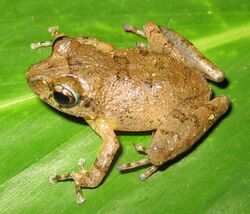Biology:Pseudophilautus
| Pseudophilautus | |
|---|---|

| |
| Adult male Pseudophilautus rus from Hantane Range, Kandy | |
| Scientific classification | |
| Domain: | Eukaryota |
| Kingdom: | Animalia |
| Phylum: | Chordata |
| Class: | Amphibia |
| Order: | Anura |
| Family: | Rhacophoridae |
| Subfamily: | Rhacophorinae |
| Genus: | Pseudophilautus Laurent, 1943 |
| Species | |
|
See text | |
Pseudophilautus is a genus of shrub frogs in the family Rhacophoridae endemic to the Western Ghats of southwestern India and to Sri Lanka where the majority of the species are found.[1] Many of them are already extinct (marked with † in the species list).[2] On the other, some species believed to be extinct have also been rediscovered.[3][4] thumb|right|Pseudophilautus amboli'', one of the Indian species
Reproduction
Frogs in genus Pseudophilautus have direct development: eggs develop directly into froglets that resemble small adults. This strategy makes fully terrestrial reproduction possible. However, the eggs still require high humidity, and periods of dry weather may be detrimental.[5]
The majority of species where reproductive behaviour is known deposit eggs in soil on the forest floor and only one (Pseudophilautus femoralis) on the leaves of understory shrubs. Males use advertisement calls to attract females, and tend to call more intensively during darkness and when humidity is high (e.g., during periods of rainfall). When a male has attracted a female to its vicinity, it approaches the female and enters the amplexus. In ground breeding species, the pair then ascends to the ground, changing colouration to match that of the leaf litter or soil, probably as camouflage. Female locates a suitable spot and excavates a cavity where the eggs are laid. After oviposition, the female mixes the eggs with soil and the male dismounts and returns to a perch. Female also leaves the site after covering the nest; there is no parental care. In leaf nesting species, the overall sequence is similar, but the pair does not change the colour. Eggs are adhesive and deposited to underside of a leaf. The female attends the eggs for few hours after oviposition, apparently to ensure that the eggs are properly attached.[5]
Eggs are 3.7–5.7 mm (0.15–0.22 in) in diameter. Egg development takes 24–68 days. Pseudophilautus embryos lack external gills but they have a relatively large, vascularized tail. It is probable that embryos use their tail for respiration. Depending on the species, froglets hatch with or without the tail fully absorbed but with the yolk sac still visible.[5]
List of species
The following species are recognised in the genus Pseudophilautus,[1] including eight species described in 2013 by Wickramasinghe and colleagues:[6]
References
- ↑ 1.0 1.1 Frost, Darrel R. (2014). "Pseudophilautus Laurent, 1943". Amphibian Species of the World: an Online Reference. Version 6.0. American Museum of Natural History. http://research.amnh.org/vz/herpetology/amphibia/Amphibia/Anura/Rhacophoridae/Rhacophorinae/Pseudophilautus.
- ↑ IUCN (2013). "IUCN Red List of Threatened Species. Version 2013.1.". http://www.iucnredlist.org/.
- ↑ Wickramasinghe, L. J. M.; D. R. Vidanapathirana; S. Airyarathne; G. Rajeev; A. Chanaka; J. Pastorini; G. Chathuranga; N. Wickramasinghe (2013). "Lost and found: One of the world's most elusive amphibians, Pseudophilautus stellatus (Kelaart 1853) rediscovered". Zootaxa 3620 (1): 112–128. doi:10.11646/zootaxa.3620.1.5. PMID 26120699. http://biotaxa.org/Zootaxa/article/view/zootaxa.3620.1.5.
- ↑ Wickramasinghe, L.J.M.; Vidanapathirana, D.R.; Rajeev, M.D.G.; Wickramasinghe, N. (2013). "Rediscovery of Pseudophilautus hypomelas (Günther, 1876) (Amphibia: Anura: Rhacophoridae) from the Peak Wilderness, Sri Lanka, a species thought to be extinct!". Journal of Threatened Taxa 5 (17): 5181–5193. doi:10.11609/jott.o3547.5181-93. http://www.threatenedtaxa.org/ZooPrintJournal/2013/December/o354726xii135181-5193.pdf.
- ↑ 5.0 5.1 5.2 Bahir, M. M.; M. Meegaskumbura; K. Manamendra-Arachchi; C. J. Schneider; R. Pethiyagoda (2005). "Reproduction and terrestrial direct development in Sri Lankan shrub frogs (Ranidae: Rhacophorinae: Philautus)". Raffles Bulletin of Zoology Suppl. 12: 339–350. http://rmbr.nus.edu.sg/rbz/biblio/s12/s12rbz339-350.pdf.
- ↑ 6.0 6.1 6.2 6.3 6.4 6.5 6.6 6.7 6.8 6.9 Wickramasinghe, L.J. Mendis; Dulan Ranga Vidanapathirana; M.D. Gehan Rajeev; S. Chathuranga Ariyarathne; A.W. Amila Chanaka; L.L. Dharshana Priyantha; Imesh Nuwan Bandara; Nethu Wickramasinghe (2013). "Eight new species of Pseudophilautus (Amphibia: Anura: Rhacophoridae) from Sripada World Heritage Site (Peak Wilderness), a local amphibian hotspot in Sri Lanka". Journal of Threatened Taxa 5 (4): 3789–3920. doi:10.11609/JoTT.o3099.3789-920.
- ↑ 7.00 7.01 7.02 7.03 7.04 7.05 7.06 7.07 7.08 7.09 7.10 7.11 7.12 7.13 7.14 7.15 7.16 7.17 7.18 7.19 7.20 7.21 7.22 7.23 7.24 7.25 7.26 Manamendra-Arachchi, K.; Pethiyagoda, R. (2005). "The Sri Lankan shrub frogs of the genus Philautus Gistel, 1848 (Ranidae: Rhacophorinae), with description of 27 new species. In: Yeo, C. J., Ng, P. K. L. & Pethiyagoda, R. (Ed.), Contributions to biodiversity exploration and research in Sri Lanka". The Raffles Bulletin of Zoology Supplement 12: 163–303. http://rmbr.nus.edu.sg/rbz/biblio/s12/s12rbz163-303.pdf.
- ↑ 8.0 8.1 8.2 8.3 8.4 8.5 Meegaskumbura M.; Manamendra-Arachchi K. (2005). "Description of eight new species of shrub frogs (Ranidae: Rhacophorinae: Philautus) from Sri Lanka. In: Yeo, C. J., Ng, P. K. L. & Pethiyagoda, R. (Ed.), Contributions to biodiversity exploration and research in Sri Lanka". The Raffles Bulletin of Zoology Supplement 12: 305–338. http://rmbr.nus.edu.sg/rbz/biblio/s12/s12rbz305-338.pdf.
- ↑ 9.0 9.1 Meegaskumbura, M.; Manamendra-Archchi, M. (2011). "Two new species of shrub frogs (Rhacophoridae: Pseudophilautus) from Sri Lanka". Zootaxa 2747: 1–18. doi:10.11646/zootaxa.2747.1.1. http://www.mapress.com/zootaxa/2011/f/z02747p018f.pdf.
- ↑ 10.0 10.1 Meegaskumbura, M.; K. Manamendra-Arachchi; C. J. Schneider; R. Pethiyagoda (2007). "New species amongst Sri Lanka's extinct shrub frogs (Amphibia: Rhacophoridae: Philautus)". Zootaxa 1397: 1–15. doi:10.11646/zootaxa.1397.1.1. http://Meegaskumbura-etal-2007_Zootaxa-2.pdf.[yes|permanent dead link|dead link}}]
Wikidata ☰ Q3016713 entry
 |

